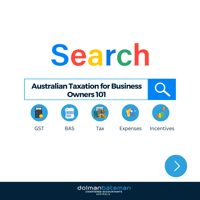Starting a Business Checklist
There is a whole range of administrative tasks that are required to start a business. This article will provide a quick overview of the steps to get your business up and running.
Step 1: Deciding on the Business Structure - Company, Partnership, Trust or Sole Trader or a Combination.
The most appropriate business structure will depend on many factors such as the nature of the business, expected risks, growth potential, expected turnover and profits, family structure, tax consequences and financial complexity.
We have written a series of articles on the different business structures and the advantages and disadvantages of each:
- Sole Trader
- Partnerships
- Discretionary Trusts
- Unit Trusts
- Companies
We always meet with our clients to discuss their needs and goals before advising on the structure because there is no hard and fast rule and a specific circumstances may rule out a business structure. Further, we may also recommend further agreements such as partnership and shareholder agreements be obtained. The initial conference with your accountant is a vital step because the consequences of the wrong structure can be very expensive.
We try to recommend a relatively simple structure for startup businesses to reduce the administrative costs, and then as the business becomes more successful and profitable introducing a more complex structure when the business can afford it.
Step 2: Registering the Company, Trust or Business Name.
This step requires that you have already chosen the name of your business and it is available, relevant to your industry and not conflicting with other brands. You should have also ensured that the domain name is available and that the domain name is not competing against a major similar name. You want your website to appear first if someone searches for your business name.
The cost of your business structure will depend upon its complexity and nature of the business.
Step 3: Obtaining Tax File Number and ABN
A TFN is a unique number issued by the Tax Office to individuals and organisations.
Partnerships, companies and trusts need their own TFN. A TFN can be obtained at the same time as an ABN, using the same application form. An application can be lodged via the business.gov.au website
Sole traders use their individual TFN in dealings with the Tax Office.
Some of the main reasons for having a TFN are:
- to quote to employers (this applies to individuals only)
- to quote to investment bodies responsible for paying interest, dividends and unit trust distributions
- to quote to government bodies, for example the Tax Office, when applying for an Australian Business Number (ABN) or lodging income tax returns.
The Australian Business Number (ABN) is a single identifier for all business dealings with the tax office and for dealings with other government departments and agencies. A business ABN must be quoted on all tax invoices and stationary issued by the entity.
Step 4: Registering your Domain Name
A .com domain does not require any pre-existing business or company name - ie. you can register whatever name you want. However a com.au domanin name will require that you own the business name or company name similar and relevant to the domain name. Therefore you will need to have registered the company or business name before your .com.au domain name registration is approved.
The cost of a com.au domain name is around $30 for a minimum of two years.
Step 5: Open a Business Bank Account
Open a bank account in the name of your business, even if it is small. You need to separate the income and expenses of your business from your personal expenses. The additional costs of bank charges will be far less than the administrative and accounting fees if you do not separate your business and personal expenses. You will need to provide certificate of incorporation and TFN & ABN to create a bank account in the name of your company. The bank will also require a identification check (100 points).
Step 6: Register of GST if applicable
Applying for an ABN is not compulsory. However, if you are required to register for GST, you will need to apply for an ABN via the Australian Business Registry website.
All businesses with a GST turnover of $75, 000 or more must register for GST and will need an ABN to do this. Organisations with a lower annual turnover may voluntarily choose to register.
Step 7: Attend to Insurance
You should speak to your insurance broker about what insurances you need to cover your employees (including yourself), damage to your business, damage to yourself, and damage to others.
In our forensic accounting role, we regularly assess business interruption claims and the claims are often reduced significantly for averaging. When meeting your insurance broker, make sure that you ask about and understand the principles of averaging and how it will affect for premiums and claims.
Step 8: Order Stationary: Business cards, letterhead
When creating your letterheads, business cards and invoices. You should be aware of the requirements in respect of the use of your company name, ABN number and the requirements for tax invoices.
For more information on the use of your company name and the ABN, ASIC have published guidelines. http://www.asic.gov.au/asic/asic.nsf/byheadline/Australian+Company+Numbers?opendocument
A valid tax invoice for taxable sales that total $1,000 or more must contain:
- the words ‘tax invoice’ stated prominently
- the name of the supplier
- the ABN of the supplier
- the name of the recipient
- the address or ABN of the recipient
- the date of issue of the tax invoice
- the quantity of the goods or the extent of the services sold
- a brief description of the things sold
- the total price of the sale (including GST).
Please refer to ATO factsheet http://www.ato.gov.au/content/downloads/n11675.pdf
Step 9: Transfer and/or apply for licences and permits
Depending your industry you need to consider whether any permits or licences need to be transferred to the new entity. If you are using a company structure for asset protection, you do not want to appear to be trading or operating through your own name.
Step 10: Establish an accounting system
When choosing an accounting system, it is important to consider a system that can grow with your business as it becomes more complex. It should also be able to automatically calculate the administrative tasks such as GST. We recommend MYOB because of the number of bookkeepers and training programs that are available. There are also cloud based (access via Internet) accounting programs such as Xero that are worth examining.
You should talk to your accountant about the design of your accounting system so that it can provide you with the information you need and grow with your business. If it is set up properly in the beginning, it will save you accounting fees and administrative headaches later on.



